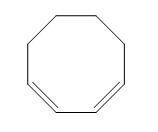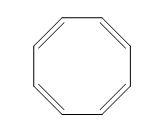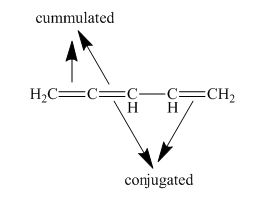
Concept explainers
(a)
Interpretation: The class of given cycloocta-1,4-diene as isolated, conjugated, cumulated, or a combination is to be stated.
Concept introduction: Conjugated systems have alternate single and double bonds that results in lower the energy and increase the stability of a molecule. Isolated dienes or polyenes are the compounds that comprise double bonds at the large distances separated by more than one single bond, whereas cumulated dienes or polyenes are the compounds that do not possess any single bond in between the two double bonds.
(a)
Answer to Problem 15.24SP
The given compound is classified as isolated diene.
Explanation of Solution
The structure of given diene is shown in figure 1.

Figure 1
It is conferred from the above structure of
(b)
Interpretation: The class of given cycloocta-1,3-diene as isolated, conjugated, cumulated, or a combination is to be stated.
Concept introduction: Conjugated systems have alternate single and double bonds that results in lower the energy and increase the stability of a molecule. Isolated dienes or polyenes are the compounds that comprise double bonds at the large distances separated by more than one single bond, whereas cumulated dienes or polyenes are the compounds that do not possess any single bond in between the two double bonds.
(b)
Answer to Problem 15.24SP
The given compound is classified as conjugated diene.
Explanation of Solution
The structure of given diene is shown in figure 2.

Figure 2
It is conferred from the above structure of
(c)
Interpretation: The class of given cycloocta-1,2-diene as isolated, conjugated, cumulated, or a combination is to be stated.
Concept introduction: Conjugated systems have alternate single and double bonds that results in lower the energy and increase the stability of a molecule. Isolated dienes or polyenes are the compounds that comprise double bonds at the large distances separated by more than one single bond, whereas cumulated dienes or polyenes are the compounds that do not possess any single bond in between the two double bonds.
(c)
Answer to Problem 15.24SP
The given compound is classified as cumulated diene.
Explanation of Solution
The structure of given diene is shown in figure 3.

Figure 3
It is conferred from the above structure of
(d)
Interpretation: The class of given cycloocta-1,2,5,7-tetraene as isolated, conjugated, cumulated, or a combination is to be stated.
Concept introduction: Conjugated systems have alternate single and double bonds that results in lower the energy and increase the stability of a molecule. Isolated dienes or polyenes are the compounds that comprise double bonds at the large distances separated by more than one single bond, whereas cumulated dienes or polyenes are the compounds that do not possess any single bond in between the two double bonds.
(d)
Answer to Problem 15.24SP
The given compound is classified as conjugated polyene.
Explanation of Solution
The structure of given polyene is shown in figure 4.

Figure 4
It is conferred from the above structure of
(e)
Interpretation: The class of given cyclohexa-1,3,5-triene as isolated, conjugated, cumulated, or a combination is to be stated.
Concept introduction: Conjugated systems have alternate single and double bonds that results in lower the energy and increase the stability of a molecule. Isolated dienes or polyenes are the compounds that comprise double bonds at the large distances separated by more than one single bond, whereas cumulated dienes or polyenes are the compounds that do not possess any single bond in between the two double bonds.
(e)
Answer to Problem 15.24SP
The given compound is classified as conjugated polyene.
Explanation of Solution
The structure of the given polyene is shown in figure 5.

Figure 5
It is conferred from the above structure of
(f)
Interpretation: The class of given penta-1,2-4-triene as isolated, conjugated, cumulated, or a combination is to be stated.
Concept introduction: Conjugated systems have alternate single and double bonds that results in lower the energy and increase the stability of a molecule. Isolated dienes or polyenes are the compounds that comprise double bonds at the large distances separated by more than one single bond, whereas cumulated dienes or polyenes are the compounds that do not possess any single bond in between the two double bonds.
(f)
Answer to Problem 15.24SP
The given compound is classified as cumulated and conjugated polyene.
Explanation of Solution
The structure of given polyene is shown in figure 6.

Figure 6
It is conferred from the above structure of
Want to see more full solutions like this?
Chapter 15 Solutions
Organic Chemistry Plus Masteringchemistry With Pearson Etext, Global Edition
- For each reaction below, decide if the first stable organic product that forms in solution will create a new C-C bond, and check the appropriate box. Next, for each reaction to which you answered "Yes" to in the table, draw this product in the drawing area below. Note for advanced students: for this problem, don't worry if you think this product will continue to react under the current conditions - just focus on the first stable product you expect to form in solution. NH2 CI MgCl ? Will the first product that forms in this reaction create a new CC bond? Yes No MgBr ? Will the first product that forms in this reaction create a new CC bond? Yes No G टेarrow_forwardFor each reaction below, decide if the first stable organic product that forms in solution will create a new CC bond, and check the appropriate box. Next, for each reaction to which you answered "Yes" to in the table, draw this product in the drawing area below. Note for advanced students: for this problem, don't worry if you think this product will continue to react under the current conditions - just focus on the first stable product you expect to form in solution. དྲ。 ✗MgBr ? O CI Will the first product that forms in this reaction create a new C-C bond? Yes No • ? Will the first product that forms in this reaction create a new CC bond? Yes No × : ☐ Xarrow_forwardPredict the major products of this organic reaction: OH NaBH4 H ? CH3OH Note: be sure you use dash and wedge bonds when necessary, for example to distinguish between major products with different stereochemistry. Click and drag to start drawing a structure. ☐ : Sarrow_forward
- Predict the major products of this organic reaction: 1. LIAIHA 2. H₂O ? Note: be sure you use dash and wedge bonds when necessary, for example to distinguish between major products with different stereochemistry. Click and drag to start drawing a structure. X : ☐arrow_forwardFor each reaction below, decide if the first stable organic product that forms in solution will create a new C - C bond, and check the appropriate box. Next, for each reaction to which you answered "Yes" to in the table, draw this product in the drawing area below. Note for advanced students: for this problem, don't worry if you think this product will continue to react under the current conditions - just focus on the first stable product you expect to form in solution. NH2 tu ? ? OH Will the first product that forms in this reaction create a new CC bond? Yes No Will the first product that forms in this reaction create a new CC bond? Yes No C $ ©arrow_forwardAs the lead product manager at OrganometALEKS Industries, you are trying to decide if the following reaction will make a molecule with a new C-C bond as its major product: 1. MgCl ? 2. H₂O* If this reaction will work, draw the major organic product or products you would expect in the drawing area below. If there's more than one major product, you can draw them in any arrangement you like. Be sure you use wedge and dash bonds if necessary, for example to distinguish between major products with different stereochemistry. If the major products of this reaction won't have a new CC bond, just check the box under the drawing area and leave it blank. Click and drag to start drawing a structure. This reaction will not make a product with a new CC bond. G marrow_forward
- Including activity coefficients, find [Hg22+] in saturated Hg2Br2 in 0.00100 M NH4 Ksp Hg2Br2 = 5.6×10-23.arrow_forwardgive example for the following(by equation) a. Converting a water insoluble compound to a soluble one. b. Diazotization reaction form diazonium salt c. coupling reaction of a diazonium salt d. indacator properties of MO e. Diazotization ( diazonium salt of bromobenzene)arrow_forward2-Propanone and ethyllithium are mixed and subsequently acid hydrolyzed. Draw and name the structures of the products.arrow_forward
- (Methanesulfinyl)methane is reacted with NaH, and then with acetophenone. Draw and name the structures of the products.arrow_forward3-Oxo-butanenitrile and (E)-2-butenal are mixed with sodium ethoxide in ethanol. Draw and name the structures of the products.arrow_forwardWhat is the reason of the following(use equations if possible) a.) In MO preperation through diazotization: Addition of sodium nitrite in acidfied solution in order to form diazonium salt b.) in MO experiment: addition of sodium hydroxide solution in the last step to isolate the product MO. What is the color of MO at low pH c.) In MO experiment: addition of sodium hydroxide solution in the last step to isolate the product MO. What is the color of MO at pH 4.5 d.) Avoiding not cooling down the reaction mixture when preparing the diazonium salt e.) Cbvcarrow_forward
 ChemistryChemistryISBN:9781305957404Author:Steven S. Zumdahl, Susan A. Zumdahl, Donald J. DeCostePublisher:Cengage Learning
ChemistryChemistryISBN:9781305957404Author:Steven S. Zumdahl, Susan A. Zumdahl, Donald J. DeCostePublisher:Cengage Learning EBK A SMALL SCALE APPROACH TO ORGANIC LChemistryISBN:9781305446021Author:LampmanPublisher:CENGAGE LEARNING - CONSIGNMENT
EBK A SMALL SCALE APPROACH TO ORGANIC LChemistryISBN:9781305446021Author:LampmanPublisher:CENGAGE LEARNING - CONSIGNMENT

